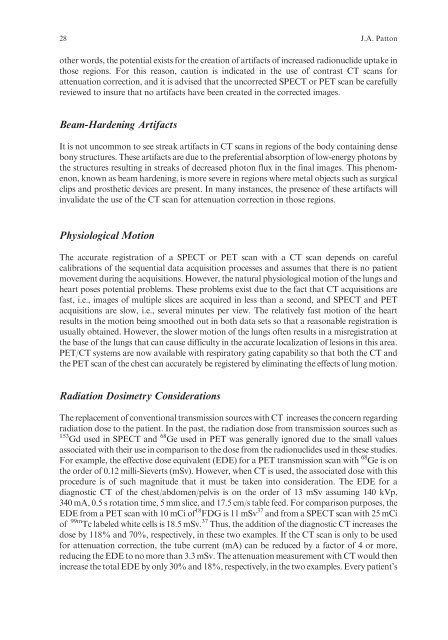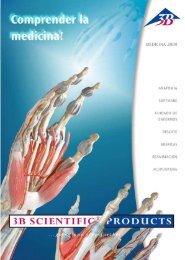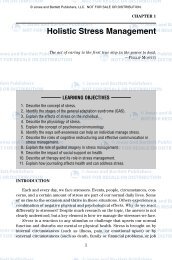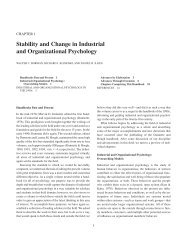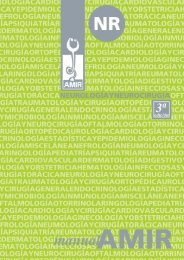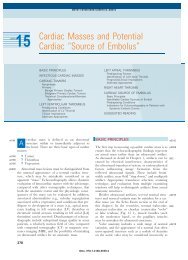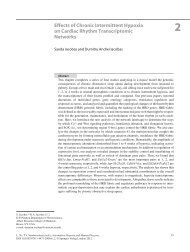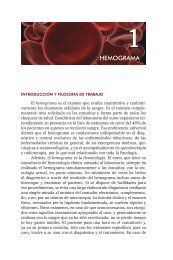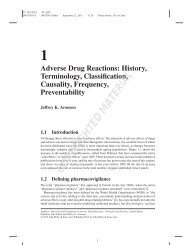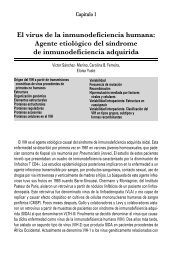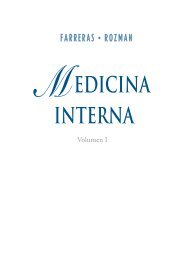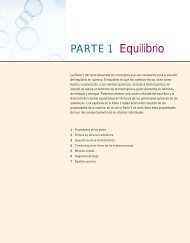Download Sample pages 1 (pdf, 5.5 MB) - Springer
Download Sample pages 1 (pdf, 5.5 MB) - Springer
Download Sample pages 1 (pdf, 5.5 MB) - Springer
Create successful ePaper yourself
Turn your PDF publications into a flip-book with our unique Google optimized e-Paper software.
28 J.A. Patton<br />
other words, the potential exists for the creation of artifacts of increased radionuclide uptake in<br />
those regions. For this reason, caution is indicated in the use of contrast CT scans for<br />
attenuation correction, and it is advised that the uncorrected SPECT or PET scan be carefully<br />
reviewed to insure that no artifacts have been created in the corrected images.<br />
Beam-Hardening Artifacts<br />
It is not uncommon to see streak artifacts in CT scans in regions of the body containing dense<br />
bony structures. These artifacts are due to the preferential absorption of low-energy photons by<br />
the structures resulting in streaks of decreased photon flux in the final images. This phenomenon,<br />
known as beam hardening, is more severe in regions where metal objects such as surgical<br />
clips and prosthetic devices are present. In many instances, the presence of these artifacts will<br />
invalidate the use of the CT scan for attenuation correction in those regions.<br />
Physiological Motion<br />
The accurate registration of a SPECT or PET scan with a CT scan depends on careful<br />
calibrations of the sequential data acquisition processes and assumes that there is no patient<br />
movement during the acquisitions. However, the natural physiological motion of the lungs and<br />
heart poses potential problems. These problems exist due to the fact that CT acquisitions are<br />
fast, i.e., images of multiple slices are acquired in less than a second, and SPECT and PET<br />
acquisitions are slow, i.e., several minutes per view. The relatively fast motion of the heart<br />
results in the motion being smoothed out in both data sets so that a reasonable registration is<br />
usually obtained. However, the slower motion of the lungs often results in a misregistration at<br />
thebaseofthelungsthatcancausedifficultyinthe accurate localization of lesions in this area.<br />
PET/CT systems are now available with respiratory gating capability so that both the CT and<br />
the PET scan of the chest can accurately be registered by eliminating the effects of lung motion.<br />
Radiation Dosimetry Considerations<br />
The replacement of conventional transmission sources with CT increases the concern regarding<br />
radiation dose to the patient. In the past, the radiation dose from transmission sources such as<br />
153 Gd used in SPECT and 68 Ge used in PET was generally ignored due to the small values<br />
associated with their use in comparison to the dose from the radionuclides used in these studies.<br />
For example, the effective dose equivalent (EDE) for a PET transmission scan with 68 Ge is on<br />
the order of 0.12 milli-Sieverts (mSv). However, when CT is used, the associated dose with this<br />
procedure is of such magnitude that it must be taken into consideration. The EDE for a<br />
diagnostic CT of the chest/abdomen/pelvis is on the order of 13 mSv assuming 140 kVp,<br />
340 mA, 0.5 s rotation time, 5 mm slice, and 17.5 cm/s table feed. For comparison purposes, the<br />
EDEfromaPETscanwith10mCiof 18 FDG is 11 mSv 37 andfromaSPECTscanwith25mCi<br />
of 99m Tc labeled white cells is 18.5 mSv. 37 Thus, the addition of the diagnostic CT increases the<br />
dose by 118% and 70%, respectively, in these two examples. If the CT scan is only to be used<br />
for attenuation correction, the tube current (mA) can be reduced by a factor of 4 or more,<br />
reducing the EDE to no more than 3.3 mSv. The attenuation measurement with CT would then<br />
increase the total EDE by only 30% and 18%, respectively, in the two examples. Every patient’s


